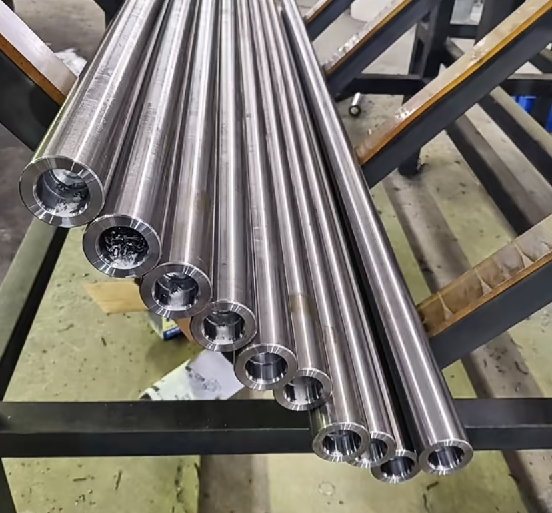
In the world of industrial machinery, automotive systems, and heavy-duty equipment, the piston rod plays a pivotal role in ensuring smooth and efficient operation. These simple yet highly essential components are used in a variety of systems, from hydraulic and pneumatic cylinders to shock absorbers. Today, we will delve into what piston rods are, their critical role in mechanical systems, and why selecting the right piston rod can make a significant difference in the performance and longevity of your equipment.
What is a Piston Rod?
A piston rod is a metal shaft that connects the piston inside a cylinder to other parts of a machine or hydraulic system. It is part of a reciprocating system that converts hydraulic or pneumatic energy into mechanical motion. In hydraulic cylinders, the piston rod is the component that moves in and out as the pressure forces the piston to move. This action drives the necessary mechanical work in various machinery, including construction equipment, manufacturing machinery, and automotive systems.
The piston rod is typically made from high-strength materials like steel and may undergo treatments such as hardening or coating to enhance its durability, reduce wear, and resist corrosion.
Key Functions of a Piston Rod
Transferring Force
The piston rod serves as the connection between the piston and the machinery’s components. It transmits the force generated by the piston’s movement, allowing it to power other parts of the machine, such as lifting arms, hydraulic presses, or even car suspension systems.Guiding Motion
The piston rod moves in and out of the cylinder in a straight line, ensuring that the piston remains aligned during operation. This linear movement is critical for ensuring that the equipment operates efficiently and safely.Absorbing and Distributing Pressure
Piston rods are subjected to intense pressure and forces during operation. Their design and material strength allow them to absorb these pressures without deformation, distributing the stress evenly across the system to prevent damage to other components.Durability and Longevity
Since piston rods are often exposed to harsh conditions, including high temperatures, friction, and corrosive environments, their durability is essential to avoid frequent repairs or replacements. High-quality piston rods made from corrosion-resistant alloys or coated with protective materials will last longer, reducing maintenance costs.
Benefits of Using High-Quality Piston Rods
Improved Efficiency and Performance
High-quality piston rods contribute to smoother movement and better performance of the hydraulic or pneumatic system. They reduce friction and wear, leading to improved operational efficiency, better responsiveness, and increased overall system performance.Reduced Maintenance and Downtime
With their high durability, well-designed piston rods need less maintenance. Choosing a premium piston rod minimizes the chances of failure or breakdown, reducing downtime and maintenance costs in the long run.Enhanced Load-Bearing Capacity
Premium piston rods are engineered to handle higher pressures and loads. They can withstand extreme conditions, making them suitable for heavy-duty industrial applications, such as mining, construction, and agricultural machinery.Corrosion Resistance
Piston rods are often subjected to moisture, dirt, and harsh chemicals. Coatings or surface treatments such as chrome-plating, nitriding, or galvanization can help resist corrosion, ensuring a longer lifespan even in corrosive environments like marine or offshore systems.
Applications of Piston Rods
Piston rods are used in a wide range of industries and applications, such as:
Hydraulic Systems
Piston rods are essential components in hydraulic cylinders, where they allow fluid power systems to generate linear motion for lifting, pressing, and other mechanical tasks.Automotive Systems
In automotive suspension systems, piston rods work with shock absorbers and struts to provide smooth ride quality by absorbing impacts from the road.Pneumatic Systems
Pneumatic cylinders use piston rods to create motion from compressed air, powering machinery in various applications such as packaging, automation, and material handling.Construction and Mining Equipment
Large-scale equipment like excavators, bulldozers, and cranes depend on robust piston rods to handle heavy lifting and provide stable movement under high loads and extreme conditions.Industrial Machinery
Piston rods are commonly found in factory machinery that requires mechanical movement, including presses, molding machines, and automated production lines.
How to Choose the Right Piston Rod for Your Application
Selecting the right piston rod for your hydraulic or pneumatic system is essential for ensuring optimal performance and longevity. When choosing a piston rod, consider the following factors:
- Material and Strength: High-quality steel, stainless steel, or alloys that are engineered for strength and durability are essential for high-pressure environments.
- Size and Compatibility: Make sure the piston rod fits precisely within your hydraulic or pneumatic system. This includes the correct length, diameter, and threading to ensure proper installation.
- Surface Treatment: Consider whether the piston rod needs additional surface treatments such as chrome plating or nitriding for corrosion resistance and improved surface hardness.
- Operating Conditions: Understand the pressure, temperature, and environmental conditions where the piston rod will be used. For high-stress applications, ensure the rod is built to handle those conditions.
- Load and Force Requirements: Choose a piston rod that can handle the specific load and force exerted during operation, ensuring it performs efficiently and lasts longer.
Conclusion
Piston rods are often overlooked, but they are an integral part of hydraulic, pneumatic, and mechanical systems. Their role in transferring force, guiding motion, and ensuring smooth operation makes them indispensable in numerous industries. By selecting high-quality piston rods, you can improve system performance, reduce maintenance costs, and enhance the longevity of your equipment.
For your next project or equipment upgrade, make sure to choose the right piston rod that meets your system’s needs. With a reliable piston rod in place, you can ensure the efficiency and reliability of your machinery for years to come.